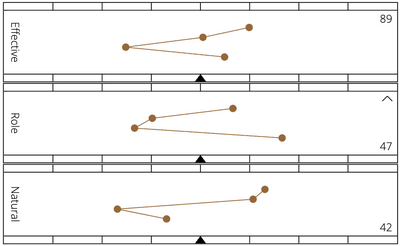Operationalizing Performance
The adaptive profiles, like the one on the right, that we measure at GRI, possess several characteristics that are central for understanding, implementing, and managing individual and organizational performance. This note lists and comments on these characteristics.
Key Characteristics
The eight key characteristics of the measures carried out by the adaptive profiles are the following:
- Quality of the measures—what's measured—on how people perform, function, and act, which is at the crossroads of their preferences, interests, mindset, how they think, value, and feel about how they behave, their beliefs about who they are, and how they interact in their environment.
- Quality of the result—the adaptive profile—that allows a concentration of significant meaning and continued learning about people and their organization.
- Adaptive nature of the measures, for understanding people in context, the energy it takes to adapt, and people's engagement.
- Behavioral aspect of the measures, and their ability to be observed, learned, shared, and validated.
- Accuracy of the measures, including their general validity, reliability over time, and predictability.
- Utility of the measures in a broad range of applications for recruitment, management, leadership and organisational development.
- Universality of the measures. The measures are independent of a person's age, gender, cultural origin, education, religious and political affiliation, and language spoken.
- Work-relatedness of the measures. The measures apply to any position in organizations, regardless of the industry, country, or hierarchy level.
Understanding Adaptation
The measures ultimately invite asking new questions about people and their organizations to perform and adapt their behaviors more effectively. At the same time, the profiles assist whenever they can be used, in the hands and minds of people and their managers, to improve or help adjust behaviors within the ranges of variability specific to each person.
With practice, the measures become a reliable source for understanding people and situations, helping to find new creative solutions for individual and organizational challenges. The solutions can be read in the profiles, which help to better align with people’s resources and behavioral values. The measures are used not only to explain why and how a behavior occurred but also to predict future behaviors, along with the thoughts and feelings associated with them, and possible solutions from teh person's perspective itself.
Making the Connection with the Job demand
Whether a person is suitable for a job also depends on whether their adaptive profile aligns with their role, which is not just about intelligence, skills, or experience. Instead, it’s about how those other characteristics develop and adapt, which the measures from the adaptive profiles can reveal. The mismatches seen between the Natural and Role profiles or between the Natural and Effective profiles and the position’s profile[1] are likely to lead to practical adjustments at the individual level, in the role in their job, their management, with colleagues and reports, for future growth within their current job or in other future job.
Seeing the Unseen
The adaptive profiles reveal characteristics that cannot be observed directly, but only subjectively and through behaviors being observed in contact with the person from time to time, indirectly through others, or from information available on them, including social media. Some characteristics, such as physical traits, diplomas, years of experience, etc., are easily accessible and observable. This is not the case for the information coming from the adaptive profiles. The behaviors being measured may reveal themselves over time and at various levels of intensity. They may often contradict our first perception and understanding of the person, something we spontaneously construct with our private concepts and techniques.
Making Sense of Other Concepts
By nature, the concepts and adjectives we use to describe people and their behaviors have different meanings. A limited number of factors—in the case of GRI, four—allow us to analyze these concepts and bring accuracy regarding their expression.
The factors were originally evidenced by analyzing a large number of adjectives used to describe behaviors. With these factors and appropriate measurement, we can describe how other concepts are being expressed, such as the way of being creative, delegating, communicating, directing, managing, leading, mentoring, teaching, learning, solving complex problems, etc.
Making Sense of the Adaptive Profiles
By the limits of variability indicated in the measures, it is possible to focus on individual actions while avoiding strong adaptation and disengagement, which will most probably lead to dissatisfaction and a lack of productivity. When there is interest in improving oneself and an organization's performance, using the adaptive profiles starts to make sense, and their applications are limitless.

